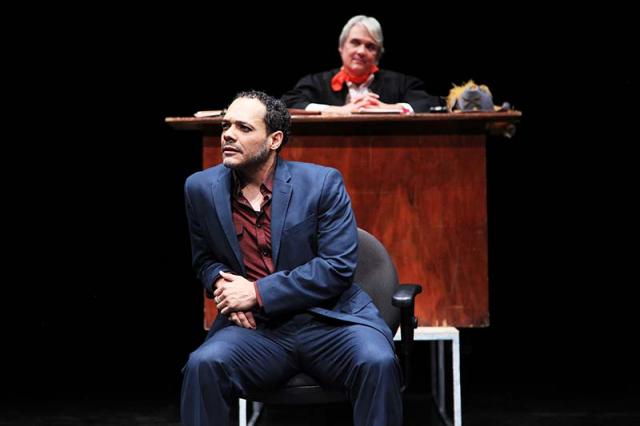
Courtroom dramas can’t be expected to have much plot. In plot, each piece of action leads to the next. In a courtroom, witnesses are called in a series without dramatic cause. And so we can’t expect Stephen Adly Guirgis’s play The Last Days of Judas Iscariot to have any sort of through line. It’s a courtroom drama, presented by La MaMa, in which Judas Iscariot is on trial. It’s not really about his last days. In fact, he isn’t on stage very much. It’s not clear why Judas is on trial after all this time. The two attorneys are, after all, our contemporaries. But Saint Monica tells us that it was her doing to bring him into court. The trial takes place in Hope, in “downtown Purgatory.” Many witnesses take the stand in this strange courtroom, including Caiaphas the Elder, Pontius Pilate, Sigmund Freud, Mother Theresa, Mary Magdalene, and a few of Apostles. It’s really an imaginative trip we’re taking. Each one reflects an aspect of the question of Judas’s guilt, and the result is a sort of quilt of issues. Each of them is interesting, but there’s no central theme. This is a multi-pronged prosecution and a multi-pronged defense. At the play’s best moments, the witnesses turn on the attorneys during questioning, and there’s some real drama in the courtroom. The star witness is Satan himself, who is called twice. The role is overwritten but well played by Javier Molina. Thus, the show’s most intense moments occur when Satan, who is omniscient, assails the attorneys with some details of their lives. However, these passages are not relevant to the central issue of Judas’s guilt. Some interesting ideas surface in the courtroom. Pilate tells us that Judas had no real remorse. Freud says that Judas was “psychotic” and, therefore, not responsible for his actions, because he was a suicide. The defense attorney asks Satan “Why do you love God?” But these individual ideas never develop into one cohesive idea. Judas himself only appears in a few dramatized scenes. In one, he meets Satan at a bar – a contemporary bar – the night after the betrayal. Satan testifies about it, and we get to see the scene. We expect this to develop into something interesting, but it never does. The two characters just chat. The other scene in which Judas appears is an interesting one at the end of the play between Judas and Jesus. It takes place not on Earth but in Purgatory. Jesus says, “If you hate who I love, you do not know me at all,” and we finally have something conceptual to hold on to. He tells Judas He loves him, and Judas spits in Jesus’s face. At the end of the play, the foreman of the jury visits Judas and confesses his relatively trivial sins. It gives us the best scene of the play. Stephen Dexter plays the penitent with genuine and subtle emotion. A quiet scene is welcome after all the yelling in the courtroom. The production is cast with about 20 members of The Actors Studio, where it was developed. Actors Studio actors have a reputation for focusing on their internal, emotional life. It isn’t true as far as this show is concerned. For the most part, their acting is highly externalized. That is, indeed, what the script calls for. Their acting is quite good. Estelle Parsons has directed the show well, with a clear distinction between its thoughtful passages and its humorous ones. She’s animated the drama between the attorneys and the witnesses, when such drama exists, and she’s laid out the humor. However, she’s cast a man as Mother Theresa, as if old people have no gender. And she’s cast the two attorneys to have cheap New York accents. The prosecuting attorney speaks with annoying, squishy S sounds. Whatever Stephen Adly Guirgis’s talents as a playwright, his self-indulgent use of obscenities is cheap and vulgar. Several of the trial’s witnesses have dialogue packed with obscenities. This type of dialogue is designed to trivialize the characters, to make us feel superior to them. St. Monica has a monologue early in the play that’s a string of obscenities. There’s no reason to think that Mr. Guirgis is commenting on the historic St. Monica. He’s just trying to shock us, like a punk who yells obscenities into the microphone when he sees a reporter on the sidewalk. Mr. Guirgis is so dependent on obscenity that the language doesn’t even make sense. It’s believable that Satan would use would use foul language when called into court, but why do the saints and apostles spew obscenities? We would expect them to have a sense of respect and decorum. After all, God himself has signed the writ that leads to the trial. Even the costume design trivializes the characters. With her low-cut blouse and jeans, the defense attorney looks as if she’s going on a low-class date at the corner bar. And so The Last Days of Judas Iscariot presents us with a promising concept that’s not mined for its potential. Most of its characters are no more than cartoons. Its various ideas aren’t imbedded into its concept and, with its obscenity and its insult to seniors, it’s offensive.
